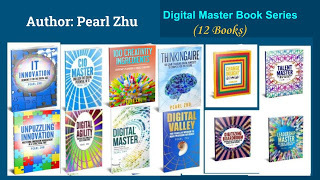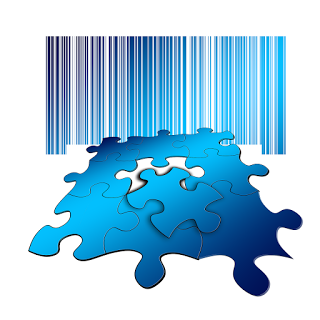Pearl Zhu's Blog, page 1260
January 15, 2017
Likability vs. Respect vs. Trust
From a leadership perspective, the liking has to be qualified and be able to garner respect.
 Respect is based on being trustworthy and authentic. Likeability is subjective, people often like people who are similar to themselves, or have a certain charisma. Being likable or popular does not always earn you the respect. Trust starts with respecting. There are differences between likeability vs. Respect. Vs. Trust.
Respect is based on being trustworthy and authentic. Likeability is subjective, people often like people who are similar to themselves, or have a certain charisma. Being likable or popular does not always earn you the respect. Trust starts with respecting. There are differences between likeability vs. Respect. Vs. Trust.
From a leadership perspective, the liking has to be qualified and be able to garner respect: Otherwise, a leader who just likes to be liked can be detrimental and indicative of someone trying to compensate for leadership and technical deficiencies. Therefore, for the leaders, you need to surround yourself with people who can complement your skills, with independent thinking, critical thinking, creative thinking capabilities, who may challenge your status quo at some point, it could mean the higher level of respect since the homogeneous setting and like-minded leadership team will execute with blind spots. Same as likability, the people's communication or interaction need to enhance the value such as time/energy management or mutual trust, no need to give up the principle for likability.
Doing the right thing at the given circumstances will earn a leader respect: When a leader or a professional consistently makes sound judgments and takes the right decisions and is perceived to be fair over the longer term, she or he earn the respect and is also liked by the majority. Earning respect comes first, liking eventually follows. People may have different value systems for trust, leading in such an environment requires acting in ways that follow the golden rule to treat others as you want to be treated, provide clear reasons to respect different POVs and decide to trust.
Trust starts with respecting: Mutual trust is that linchpin without which leadership is hollow and ineffective. The more we understand its vitality and the anatomy, the better will be our ability to lead in different situations. From talent management perspective, there are so many things employees will not tell their managers what's in their mind, and unfortunately, there are not so many things that are positives. It is an indication of a lack of trust. Communication is the very way to build trust, and lack of trust is an often overlooked barrier to communication as well.
 Trust is based on credibility: Credibility is not the same thing as being likable. Credibility requires competence as one of the factors that encourage where credibility emerges. It is a perceived quality that others assign to you based on the interplay of a number of elements, such as integrity, competence (expertise), sound judgment, relational sensitivity, and likeability. Likeability and Credibility are two complex qualities that emerge from a handful of factors.
Trust is based on credibility: Credibility is not the same thing as being likable. Credibility requires competence as one of the factors that encourage where credibility emerges. It is a perceived quality that others assign to you based on the interplay of a number of elements, such as integrity, competence (expertise), sound judgment, relational sensitivity, and likeability. Likeability and Credibility are two complex qualities that emerge from a handful of factors.
Mutual trust, mutual respect: No blind trust or trust too little. Leaders need show staff that you respect them, first, understand what they care, trust them in a safe environment. Help them not to fail, and if they do, show yourself to be trustworthy by supporting them. That will motivate them more than just throwing out some platitudes about trust as the opposite of micro-managing.
Overall, as a digital leader or professional being respected with fair value, it is important to make effective decisions for the organization and majority of people, also live fulfilled life with the energy and consistency, be athletic, learning agile, build professional capabilities, and keep the positive emotion flow.Follow us at: @Pearl_Zhu
 Respect is based on being trustworthy and authentic. Likeability is subjective, people often like people who are similar to themselves, or have a certain charisma. Being likable or popular does not always earn you the respect. Trust starts with respecting. There are differences between likeability vs. Respect. Vs. Trust.
Respect is based on being trustworthy and authentic. Likeability is subjective, people often like people who are similar to themselves, or have a certain charisma. Being likable or popular does not always earn you the respect. Trust starts with respecting. There are differences between likeability vs. Respect. Vs. Trust.
From a leadership perspective, the liking has to be qualified and be able to garner respect: Otherwise, a leader who just likes to be liked can be detrimental and indicative of someone trying to compensate for leadership and technical deficiencies. Therefore, for the leaders, you need to surround yourself with people who can complement your skills, with independent thinking, critical thinking, creative thinking capabilities, who may challenge your status quo at some point, it could mean the higher level of respect since the homogeneous setting and like-minded leadership team will execute with blind spots. Same as likability, the people's communication or interaction need to enhance the value such as time/energy management or mutual trust, no need to give up the principle for likability.
Doing the right thing at the given circumstances will earn a leader respect: When a leader or a professional consistently makes sound judgments and takes the right decisions and is perceived to be fair over the longer term, she or he earn the respect and is also liked by the majority. Earning respect comes first, liking eventually follows. People may have different value systems for trust, leading in such an environment requires acting in ways that follow the golden rule to treat others as you want to be treated, provide clear reasons to respect different POVs and decide to trust.
Trust starts with respecting: Mutual trust is that linchpin without which leadership is hollow and ineffective. The more we understand its vitality and the anatomy, the better will be our ability to lead in different situations. From talent management perspective, there are so many things employees will not tell their managers what's in their mind, and unfortunately, there are not so many things that are positives. It is an indication of a lack of trust. Communication is the very way to build trust, and lack of trust is an often overlooked barrier to communication as well.
 Trust is based on credibility: Credibility is not the same thing as being likable. Credibility requires competence as one of the factors that encourage where credibility emerges. It is a perceived quality that others assign to you based on the interplay of a number of elements, such as integrity, competence (expertise), sound judgment, relational sensitivity, and likeability. Likeability and Credibility are two complex qualities that emerge from a handful of factors.
Trust is based on credibility: Credibility is not the same thing as being likable. Credibility requires competence as one of the factors that encourage where credibility emerges. It is a perceived quality that others assign to you based on the interplay of a number of elements, such as integrity, competence (expertise), sound judgment, relational sensitivity, and likeability. Likeability and Credibility are two complex qualities that emerge from a handful of factors.
Mutual trust, mutual respect: No blind trust or trust too little. Leaders need show staff that you respect them, first, understand what they care, trust them in a safe environment. Help them not to fail, and if they do, show yourself to be trustworthy by supporting them. That will motivate them more than just throwing out some platitudes about trust as the opposite of micro-managing.
Overall, as a digital leader or professional being respected with fair value, it is important to make effective decisions for the organization and majority of people, also live fulfilled life with the energy and consistency, be athletic, learning agile, build professional capabilities, and keep the positive emotion flow.Follow us at: @Pearl_Zhu
Published on January 15, 2017 22:55
Likeability vs. Respect vs. Trust
 Respect is based on being trustworthy and authentic. Likeability is subjective, people often like people who are similar to themselves. Being likeable or popular does not always earn you the respect. Trust starts with respecting. There are differences between likeability vs. Respect. Vs. Trust.
Respect is based on being trustworthy and authentic. Likeability is subjective, people often like people who are similar to themselves. Being likeable or popular does not always earn you the respect. Trust starts with respecting. There are differences between likeability vs. Respect. Vs. Trust.
From leadership perspective, the liking has to be qualified and be able to garner respect: Otherwise, a leader who just likes to be liked can be detrimental and indicative of someone trying to compensate for leadership and technical deficiencies. Therefore, for the leaders, you need to surround yourself with people who can complement your skills, with independent thinking, critical thinking, creative thinking capabilities, who may challenge your status quo at some point, it could mean the higher level of respect since the homogeneous setting and like-minded leadership team will execute with blind spots. Same as likability, the people's communication or interaction need to enhance the value such as time/energy management or mutual trust, no need to give up the principle for likability
Doing the right thing at the given circumstances will earn a leader respect: When a leader or a professional consistently makes sound judgments and takes the right decisions and is perceived to be fair over the longer term, she or he earn the respect and is also liked by the majority. Earning respect comes first, liking eventually follows. People may have different value systems for trust, leading in such an environment requires acting in ways that follow the golden rule to treat others as you want to be treated, provide clear reasons to respect different PoVs and decide to trust.
Trust starts with respecting: Mutual trust is that linchpin without which leadership is hollow and ineffective. The more we understand its vitality and the anatomy, the better will be our ability to lead in different situations. From talent management perspective, there are so many things employees will not tell their managers what's in their mind, and unfortunately, there are not so many things that are positives. It is an indication of a lack of trust. Communication is the very way to build trust, and lack of trust is an often overlooked barrier to communication as well.
 Trust is based on credibility: Credibility is not the same thing as being likeable. Credibility requires competence as one of the factors that encourage where credibility emerges. It is a perceived quality that others assign to you based on the interplay of a number of elements, such as integrity, competence (expertise), sound judgment, relational sensitivity, and likeability. Likeability and Credibility are two complex qualities that emerge from a handful of factors.
Trust is based on credibility: Credibility is not the same thing as being likeable. Credibility requires competence as one of the factors that encourage where credibility emerges. It is a perceived quality that others assign to you based on the interplay of a number of elements, such as integrity, competence (expertise), sound judgment, relational sensitivity, and likeability. Likeability and Credibility are two complex qualities that emerge from a handful of factors.
Mutual trust, mutual respect: No blind trust or trust too little. Leader need show staff that you respect them, first, understand what they care, trust them in a safe environment. Help them not to fail, and if they do, show yourself to be trustworthy by supporting them. That will motivate them more than just throwing out some platitudes about trust as the opposite of micro-managing.
Overall, as a digital leader or professional being respected with fair value, it is important to make effective decisions for the organization and majority of people, also live fulfilled life with the energy and consistency, be athletic, learning agile, build professional capabilities, and keep the positive emotion flow.Follow us at: @Pearl_Zhu
Published on January 15, 2017 22:55
Achieving IT Premium via Three Excellences
The ultimate goal is to push the IT organization to be clear about its position via the company's core business strategy and pull all the resources for achieving the multilevel of the business excellence.
 Businesses large and small are on the journey of digital transformation, nowadays IT becomes the change driver and the business differentiator. Companies that lacked the skills to manage information technology effectively suffered compared with competitors that had mastered those skills. Business needs IT to deliver services/ solutions that drive business productivity and effectiveness, and IT needs to achieve premium via the multitude of the management excellence.
Businesses large and small are on the journey of digital transformation, nowadays IT becomes the change driver and the business differentiator. Companies that lacked the skills to manage information technology effectively suffered compared with competitors that had mastered those skills. Business needs IT to deliver services/ solutions that drive business productivity and effectiveness, and IT needs to achieve premium via the multitude of the management excellence.
Operational Excellence: IT plays a crucial role in optimizing business operation management capacity with a keen eye to grasp growth opportunities, manage risks, and improve operational efficiency via applying lightweight technologies seamlessly. IT helps to integrate/optimize/orchestrate business processes to facilitate the business outcomes and build an effective digital ecosystem. By nature, technology is complex, every intelligence has complexity behind it, though it doesn’t mean IT should make things more and more complicated. In fact, “Keep it Simple” should always be one of the guiding principles and management cultures for running IT to achieve operational excellence. IT is the lubricant to a well-designed business system, hence, IT management needs to be in the continuous tuning mode through consolidation, modernization, integration, and optimization, streamline IT processes, and tighten coordination and collaboration with the business partners. Many IT organizations suffer from overloaded tasks and overwhelming information, prioritization brings transparency and aligns IT portfolio management with the strategic business goals and objectives. When a CIO is able to position and maintain the IT organization to ensure it addresses both "IT effectiveness" and "IT efficiency," to achieve operational excellence, they have earned their stripes.
Innovation Excellence: It is not enough for IT to just “Keep the lights on,” CIOs need to reinvent IT via “Doing more with innovation.” Leadership towards true value creation for any organization will come from the willingness of its leaders to knock down the barriers separating insulated IT teams and the revenue generating business ownership teams. CIOs need to become business leaders within IT and seek ways to grow revenues, profitability and spur innovation. That's a completely different mindset than managing technology only. Running IT as an innovative outlier is truly about bringing the new perspective to grow businesses and delight customers; to both capture opportunities and manage risks timely, to become customer-centric and business focused. To run an innovative IT organization, the more difficult challenge is not just launching successful teams, but maintaining the motivation and focus of the people. The intersection of IT and people is where innovation happens; companies need to invest in IT necessary to advance businesses through either incremental or radical innovation. IT can achieve the innovation excellence if IT is regarded as a strategic business partner and given the role in catalyzing innovation and driving the business transformation.
 Digital Workforce Excellence: As the digitized world becomes hyper-connected, over-complex and interdependent, the bar is actually raised higher either being a digital leader or being a digital professional. Because, nowadays, the line between our professional life and personal life is blurring, thanks for the technology to make everything so transparent. Being a digital professional means consistency to be who you are, thinking independently with the capability to make a good judgment, being clear about his/her responsibility and added value in the organization; and corporations also should inspire people to grow and become who they want to be. The advanced digital workforce continues to depoliticize working culture, dismantle bureaucracy, solve business problems via multi-dimensional thinking processes and multiple choice of solutions, think out of the box, pack it in a new box which then creates a new innovative idea. IT also plays a crucial role in empowering digital workforce with efficient tools to improving productivity, achieving workforce excellence, and integrating people, process, and technology into the differentiated business competency.
Digital Workforce Excellence: As the digitized world becomes hyper-connected, over-complex and interdependent, the bar is actually raised higher either being a digital leader or being a digital professional. Because, nowadays, the line between our professional life and personal life is blurring, thanks for the technology to make everything so transparent. Being a digital professional means consistency to be who you are, thinking independently with the capability to make a good judgment, being clear about his/her responsibility and added value in the organization; and corporations also should inspire people to grow and become who they want to be. The advanced digital workforce continues to depoliticize working culture, dismantle bureaucracy, solve business problems via multi-dimensional thinking processes and multiple choice of solutions, think out of the box, pack it in a new box which then creates a new innovative idea. IT also plays a crucial role in empowering digital workforce with efficient tools to improving productivity, achieving workforce excellence, and integrating people, process, and technology into the differentiated business competency.
The multidimensional digital effects provide impressive advantages in term of the speed of delivery, the quality of information for decision making, the responsiveness of the business, and the wisdom of digital workforces. The ultimate goal is to push the IT organization to be clear about its position via the company's core business strategy and pull all the resources for achieving the multilevel of the business excellence. Once that's clear, the CIO must re-enforce that position by demonstrating every day how IT contributes to it, to do more with less, but also do more with innovation.
Follow us at: @Pearl_Zhu
 Businesses large and small are on the journey of digital transformation, nowadays IT becomes the change driver and the business differentiator. Companies that lacked the skills to manage information technology effectively suffered compared with competitors that had mastered those skills. Business needs IT to deliver services/ solutions that drive business productivity and effectiveness, and IT needs to achieve premium via the multitude of the management excellence.
Businesses large and small are on the journey of digital transformation, nowadays IT becomes the change driver and the business differentiator. Companies that lacked the skills to manage information technology effectively suffered compared with competitors that had mastered those skills. Business needs IT to deliver services/ solutions that drive business productivity and effectiveness, and IT needs to achieve premium via the multitude of the management excellence.
Operational Excellence: IT plays a crucial role in optimizing business operation management capacity with a keen eye to grasp growth opportunities, manage risks, and improve operational efficiency via applying lightweight technologies seamlessly. IT helps to integrate/optimize/orchestrate business processes to facilitate the business outcomes and build an effective digital ecosystem. By nature, technology is complex, every intelligence has complexity behind it, though it doesn’t mean IT should make things more and more complicated. In fact, “Keep it Simple” should always be one of the guiding principles and management cultures for running IT to achieve operational excellence. IT is the lubricant to a well-designed business system, hence, IT management needs to be in the continuous tuning mode through consolidation, modernization, integration, and optimization, streamline IT processes, and tighten coordination and collaboration with the business partners. Many IT organizations suffer from overloaded tasks and overwhelming information, prioritization brings transparency and aligns IT portfolio management with the strategic business goals and objectives. When a CIO is able to position and maintain the IT organization to ensure it addresses both "IT effectiveness" and "IT efficiency," to achieve operational excellence, they have earned their stripes.
Innovation Excellence: It is not enough for IT to just “Keep the lights on,” CIOs need to reinvent IT via “Doing more with innovation.” Leadership towards true value creation for any organization will come from the willingness of its leaders to knock down the barriers separating insulated IT teams and the revenue generating business ownership teams. CIOs need to become business leaders within IT and seek ways to grow revenues, profitability and spur innovation. That's a completely different mindset than managing technology only. Running IT as an innovative outlier is truly about bringing the new perspective to grow businesses and delight customers; to both capture opportunities and manage risks timely, to become customer-centric and business focused. To run an innovative IT organization, the more difficult challenge is not just launching successful teams, but maintaining the motivation and focus of the people. The intersection of IT and people is where innovation happens; companies need to invest in IT necessary to advance businesses through either incremental or radical innovation. IT can achieve the innovation excellence if IT is regarded as a strategic business partner and given the role in catalyzing innovation and driving the business transformation.
 Digital Workforce Excellence: As the digitized world becomes hyper-connected, over-complex and interdependent, the bar is actually raised higher either being a digital leader or being a digital professional. Because, nowadays, the line between our professional life and personal life is blurring, thanks for the technology to make everything so transparent. Being a digital professional means consistency to be who you are, thinking independently with the capability to make a good judgment, being clear about his/her responsibility and added value in the organization; and corporations also should inspire people to grow and become who they want to be. The advanced digital workforce continues to depoliticize working culture, dismantle bureaucracy, solve business problems via multi-dimensional thinking processes and multiple choice of solutions, think out of the box, pack it in a new box which then creates a new innovative idea. IT also plays a crucial role in empowering digital workforce with efficient tools to improving productivity, achieving workforce excellence, and integrating people, process, and technology into the differentiated business competency.
Digital Workforce Excellence: As the digitized world becomes hyper-connected, over-complex and interdependent, the bar is actually raised higher either being a digital leader or being a digital professional. Because, nowadays, the line between our professional life and personal life is blurring, thanks for the technology to make everything so transparent. Being a digital professional means consistency to be who you are, thinking independently with the capability to make a good judgment, being clear about his/her responsibility and added value in the organization; and corporations also should inspire people to grow and become who they want to be. The advanced digital workforce continues to depoliticize working culture, dismantle bureaucracy, solve business problems via multi-dimensional thinking processes and multiple choice of solutions, think out of the box, pack it in a new box which then creates a new innovative idea. IT also plays a crucial role in empowering digital workforce with efficient tools to improving productivity, achieving workforce excellence, and integrating people, process, and technology into the differentiated business competency.
The multidimensional digital effects provide impressive advantages in term of the speed of delivery, the quality of information for decision making, the responsiveness of the business, and the wisdom of digital workforces. The ultimate goal is to push the IT organization to be clear about its position via the company's core business strategy and pull all the resources for achieving the multilevel of the business excellence. Once that's clear, the CIO must re-enforce that position by demonstrating every day how IT contributes to it, to do more with less, but also do more with innovation.
Follow us at: @Pearl_Zhu
Published on January 15, 2017 22:51
Achieving IT Premium via Three IT Excellence
 Businesses large and small are on the journey of digital transformation, nowadays IT becomes the change driver and the business differentiator. Companies that lacked the skills to manage information technology effectively suffered compared with competitors that had mastered those skills. Business needs IT to deliver services / solutions that drive business productivity and effectiveness, and IT needs to achieve premium via the multitude of the management excellence.
Businesses large and small are on the journey of digital transformation, nowadays IT becomes the change driver and the business differentiator. Companies that lacked the skills to manage information technology effectively suffered compared with competitors that had mastered those skills. Business needs IT to deliver services / solutions that drive business productivity and effectiveness, and IT needs to achieve premium via the multitude of the management excellence.
Operational Excellence: IT plays a crucial role in optimizing business operation management capacity with a keen eye to grasp growth opportunities, manage risks, and improve operational efficiency via applying lightweight technologies seamlessly. IT helps to integrate/optimize/orchestrate business processes to facilitate the business outcomes and build an effective digital ecosystem. By nature, technology is complex, every intelligence has complexity behind it, it doesn’t mean IT should make things more and more complicated. In fact, “Keep it Simple” should always be one of the guiding principles and management culture for running IT to achieve operational excellence. IT is the lubricant to a well-designed business system, hence, IT management needs to be in the continuous tuning mode through consolidation, modernization, integration, and optimization, streamline IT processes, and tighten coordination and collaboration with the business partners. Many IT organizations suffer from overloaded tasks and overwhelming information, prioritization brings transparency and aligns IT portfolio management with the strategic business goals and objectives. When a CIO is able to position and maintain the IT organization to ensure it addresses both "IT effectiveness" and "IT efficiency," to achieve operational excellence, they have earned their stripes.
Innovation Excellence: It is not enough for IT to just “Keep the lights on,” CIOs need to reinvent IT via “Doing more with innovation.” Leadership towards true value creation for any organization will come from the willingness of its leaders to knock down the barriers separating insulated IT teams and the revenue generating business ownership teams. CIOs need to become business leaders within IT and seek ways to grow revenues, profitability and spur innovation. That's a completely different mindset than managing technology only. Running IT as an innovative outlier is truly about bringing the new perspective to grow businesses and delight customers; to both capture opportunities and manage risks timely, to become customer-centric and business focused. To run an innovative IT organization, the more difficult challenge is not just launching successful teams, but maintaining the motivation and focus of the people. The intersection of IT and people is where innovation happens; companies need to invest in IT necessary to advance businesses through either incremental or radical innovation. IT can achieve the innovation excellence if IT is regarded as a strategic business partner and given the role in catalyzing innovation and driving the business transformation.
 Digital Workforce Excellence: As the digitized world becomes hyper-connected, over-complex and interdependent, the bar is actually raised higher either being a digital leader or being a digital professional. Because, nowadays, the line between our professional life and personal life is blurring, thanks for the technology to make everything so transparent. Being a digital professional means consistency to be who you are, thinking independently with the capability to make a good judgment, who is clear about his/her responsibility and added value in the organization; and corporations also should inspire people to grow and become who they want to be. The advanced digital workforce continues to depoliticize working culture, dismantle bureaucracy, solve business problems via multi-dimensional thinking processes and multiple choice of solutions, think out of the box, pack it in a new box which then creates a new innovative idea. IT also plays a crucial role for empowering digital workforce with efficient tools to improving productivity, achieving workforce excellence, and integrating people, process, and technology into the differentiated business competency.
Digital Workforce Excellence: As the digitized world becomes hyper-connected, over-complex and interdependent, the bar is actually raised higher either being a digital leader or being a digital professional. Because, nowadays, the line between our professional life and personal life is blurring, thanks for the technology to make everything so transparent. Being a digital professional means consistency to be who you are, thinking independently with the capability to make a good judgment, who is clear about his/her responsibility and added value in the organization; and corporations also should inspire people to grow and become who they want to be. The advanced digital workforce continues to depoliticize working culture, dismantle bureaucracy, solve business problems via multi-dimensional thinking processes and multiple choice of solutions, think out of the box, pack it in a new box which then creates a new innovative idea. IT also plays a crucial role for empowering digital workforce with efficient tools to improving productivity, achieving workforce excellence, and integrating people, process, and technology into the differentiated business competency.
The multidimensional digital effects provide impressive advantages in term of the speed of delivery, the quality of information for decision making, the responsiveness of the business, and the wisdom of digital workforces. The ultimate goal is to push the IT organization to be clear about its position via the company's core business strategy, and pull all the resources for achieving the multilevel of the business excellence. Once that's clear, the CIO must re-enforce that position by demonstrating every day how IT contributes to it, to do more with less, but also do more with innovation.
Follow us at: @Pearl_Zhu
Published on January 15, 2017 22:51
January 14, 2017
The Popular Quotes Collection of “Digital Master” Book Series
 “Digital Master” is the series of guidebooks (12+ books) with five pillars to perceive the multifaceted impact digital is making to the business and our society, help forward-thinking organizations navigate through the digital journey in a systematic way, and avoid “rogue digital.” Here is the set of popular quotes for conveying the digital vision and sharing the unique insight about the digital transformation.
“Digital Master” is the series of guidebooks (12+ books) with five pillars to perceive the multifaceted impact digital is making to the business and our society, help forward-thinking organizations navigate through the digital journey in a systematic way, and avoid “rogue digital.” Here is the set of popular quotes for conveying the digital vision and sharing the unique insight about the digital transformation.
 It Innovation: Reinvent It for the Digital Age by Pearl Zhu
It Innovation: Reinvent It for the Digital Age by Pearl Zhu
The function of the bridge is to mind the gap; the wonder of the bridge is to create a scene.” ― Pearl Zhu, It Innovation: Reinvent It for the Digital Age
“A transformation often needs to break down the outdated rules, and a transaction is following the rules.” ― Pearl Zhu, It Innovation: Reinvent It for the Digital Age
“Digital organizations can become hyper-connected and “super-creative” via dealing with innovation dilemmas collectively.”― Pearl Zhu, It Innovation: Reinvent It for the Digital Age
“Develop talent for tomorrow, rather than just hire for yesterday.” ― Pearl Zhu, It Innovation: Reinvent It for the Digital Age
“As a CIO, you need to understand what the organization’s expectation from IT through innovation lenses.”― Pearl Zhu, It Innovation: Reinvent It for the Digital Age
 Thinkingaire: 100 Game Changing Digital Mindsets to Compete for the Future
Thinkingaire: 100 Game Changing Digital Mindsets to Compete for the Future
“Thought leadership is by nature evolutionary, in that it must always be part of an ever-evolving flow.” ― Pearl Zhu, Thinkingaire: 100 Game Changing Digital Mindsets to Compete for the Future
“Inspiration is the result of moments of insight and a key component of internal “drive.” ― Pearl Zhu, Thinkingaire: 100 Game Changing Digital Mindsets to Compete for the Future
“The brain is to mind as the eye is to sight.”― Pearl Zhu, Thinkingaire: 100 Game Changing Digital Mindsets to Compete for the Future
“A mind is not profound by itself, just like a tree without a root.” ― Pearl Zhu, Thinkingaire: 100 Game Changing Digital Mindsets to Compete for the Future
“Cognition can happen in many different ways and combinations.” ― Pearl Zhu, Thinkingaire: 100 Game Changing Digital Mindsets to Compete for the Future
 CIO Master: Unleash the Digital Potential of IT by Pearl Zhu b
CIO Master: Unleash the Digital Potential of IT by Pearl Zhu b
“A problem-solving mind focuses on keeping the end in mind, to solve PROBLEMS in optimal ways.”― Pearl Zhu, CIO Master: Unleash the Digital Potential of It
“One of the most influential aspects of people's psychology is how they perceive the world around them and how they relate to it.”― Pearl Zhu, CIO Master: Unleash the Digital Potential of It
“IT more often needs to play a pivotal role in discovering the path to strategy implementation.” ― Pearl Zhu, CIO Master: Unleash the Digital Potential of It
“Digital IT is all about speed, agility, and flexibility.” ― Pearl Zhu, CIO Master: Unleash the Digital Potential of It
“IT delivery is about People, Process, and Technology.”― Pearl Zhu, CIO Master: Unleash the Digital Potential of It
 Digitizing Boardroom: The Multifaceted Aspects of Digital Ready Boards by Pearl Zhu
Digitizing Boardroom: The Multifaceted Aspects of Digital Ready Boards by Pearl Zhu
“The Board must set a tone for digital leadership.” ― Pearl Zhu, Digitizing Boardroom: The Multifaceted Aspects of Digital Ready Boards
“The digital Board will help set the principles to innovate talent management and embrace digital fitness.” ― Pearl Zhu, Digitizing Boardroom: The Multifaceted Aspects of Digital Ready Boards
“The BoDs and business leaders must work with the right mindset to make good policies and create an inclusive organization with every dip in the business life cycle.”― Pearl Zhu, Digitizing Boardroom: The Multifaceted Aspects of Digital Ready Boards
“Being digital-ready is an overarching approach via building a set of “digital -flavored” cultures and taking a series of stepwise practices.”― Pearl Zhu, Digitizing Boardroom: The Multifaceted Aspects of Digital Ready Boards
“The Boardroom Paradox: Harden the softest like culture, and soften the hardest like number.” ― Pearl Zhu, Digitizing Boardroom: The Multifaceted Aspects of Digital Ready Boards
 Unpuzzling Innovation: Mastering Innovation Management in a Structural Way by Pearl Zhu
Unpuzzling Innovation: Mastering Innovation Management in a Structural Way by Pearl Zhu
“You cannot “disrupt” without incremental innovation being part of the process.”― Pearl Zhu, Unpuzzling Innovation: Mastering Innovation Management in a Structural Way
“The very nature of open innovation is to take advantage of all sources of creativity in a more open way and make a leap of innovation management to the next level.”― Pearl Zhu, Unpuzzling Innovation: Mastering Innovation Management in a Structural Way
“The mindset, vision, competency, capability, culture and marketing opportunity are all great starting point for business model innovation.”― Pearl Zhu, Unpuzzling Innovation: Mastering Innovation Management in a Structural Way
“Management innovation has both hard elements such as process and metrics; and soft elements such as communication and culture.” ― Pearl Zhu, Unpuzzling Innovation: Mastering Innovation Management in a Structural Way
The best way to foster creativity is to help people communicate in a way that instills confidence, not fear.”― Pearl Zhu, Unpuzzling Innovation: Mastering Innovation Management in a Structural Way
 Change Insight: Change as an Ongoing Capability to Fuel Digital Transformation by Pearl Zhu“Be humble, desire insight, squash arrogance, and be cognizance of unknown.” ― Pearl Zhu, Change Insight: Change as an Ongoing Capability to Fuel Digital Transformation“Change Management can become more successful with people at the core of change, the cause of change and the purpose of change.” ― Pearl Zhu, Change Insight: Change as an Ongoing Capability to Fuel Digital Transformation“Innovation is the change, Change Management needs to be an integral part of innovation management.” ― Pearl Zhu, Change Insight: Change as an Ongoing Capability to Fuel Digital Transformation“The “result” of micromanagement is perhaps tangible in the short run, but more often causes damage for the long term.” ― Pearl Zhu, Change Insight: Change as an Ongoing Capability to Fuel Digital Transformation“The “result” of micromanagement is perhaps tangible in the short run, but more often causes damage for the long term.” ― Pearl Zhu, Change Insight: Change as an Ongoing Capability to Fuel Digital Transformation“To think critically, it is first maturing and distancing a bit from self, no matter what level one lives on Maslow’s hierarchy of needs.” ― Pearl Zhu, Change Insight: Change as an Ongoing Capability to Fuel Digital TransformationFollow us at: @Pearl_Zhu
Change Insight: Change as an Ongoing Capability to Fuel Digital Transformation by Pearl Zhu“Be humble, desire insight, squash arrogance, and be cognizance of unknown.” ― Pearl Zhu, Change Insight: Change as an Ongoing Capability to Fuel Digital Transformation“Change Management can become more successful with people at the core of change, the cause of change and the purpose of change.” ― Pearl Zhu, Change Insight: Change as an Ongoing Capability to Fuel Digital Transformation“Innovation is the change, Change Management needs to be an integral part of innovation management.” ― Pearl Zhu, Change Insight: Change as an Ongoing Capability to Fuel Digital Transformation“The “result” of micromanagement is perhaps tangible in the short run, but more often causes damage for the long term.” ― Pearl Zhu, Change Insight: Change as an Ongoing Capability to Fuel Digital Transformation“The “result” of micromanagement is perhaps tangible in the short run, but more often causes damage for the long term.” ― Pearl Zhu, Change Insight: Change as an Ongoing Capability to Fuel Digital Transformation“To think critically, it is first maturing and distancing a bit from self, no matter what level one lives on Maslow’s hierarchy of needs.” ― Pearl Zhu, Change Insight: Change as an Ongoing Capability to Fuel Digital TransformationFollow us at: @Pearl_Zhu
Published on January 14, 2017 23:37
Critical Thinking Gaps
 Critical Thinking is the mental process of actively and skillfully conceptualizing, applying, analyzing, synthesizing, and evaluating information to reach an answer or conclusion. There are very few real critical thinkers because it is a complex type of thinking with the multitude of thought process, at the deeper level, critical thinking has creativity embedded in it. Critical Thinking technique can be taught, but Critical Thinking skills can only be developed via practicing independent thinking, insightful observation, and conscious and even superconscious reasoning. There are critical thinking gaps existing which cause leadership blind spots and poor decision making, how to identify and fill them to improve the leadership maturity and digital professionalism?
Critical Thinking is the mental process of actively and skillfully conceptualizing, applying, analyzing, synthesizing, and evaluating information to reach an answer or conclusion. There are very few real critical thinkers because it is a complex type of thinking with the multitude of thought process, at the deeper level, critical thinking has creativity embedded in it. Critical Thinking technique can be taught, but Critical Thinking skills can only be developed via practicing independent thinking, insightful observation, and conscious and even superconscious reasoning. There are critical thinking gaps existing which cause leadership blind spots and poor decision making, how to identify and fill them to improve the leadership maturity and digital professionalism?
The gap between proactive thinking and passive thinking: Passive thinking is taking things as they come and not really asking questions or analyzing the information presented for its value. Critical thinking is analyzing, looking beyond the surface, not just accepting things at face value but asking questions and being active in your thought processes. We all have a cognitive bias, whether individually or collectively, it is no surprise to create the thinking gaps by imperfect people using imperfect processes via the narrow lenses. By practicing critical thinking, it implies some systematic methodology, employing and applying the criteria deemed appropriate by the thinkers involved, to arrive at the tangible and reproducible truth for minding the gaps and enforce understanding.
The gaps between impoverished thinking and resourceful/ imaginable thinking: Critical thinking doesn't always cross over to include imaginative or resourceful thinking. Because the opposite of critical thinking would be unimaginative, evidence-driven, limited, and impoverished thinking often leads to the same old expected solutions. The real critical thinking far outweighs than the conventional critical thinking techniques, such as reason, logic, calculation, and conscious weighing of expected outcomes, etc. It has to ability to catch the trends and discovery of hidden connections. It involves significant critical thinking elements relying heavily on the judgment in evaluating ideas, and planning implementations and evaluating results. Also, when the environment is "fast," we have to employ good thinking fast. It is the employment a Critical Thinking "Trigger," before deciding on a course of action.
 The gaps between convenience thinking and mindful thinking: Many people still get stuck in the “think less” mentality - thinker of convenience, or avoid thinking deeply, just believe what being told blindly. In this age of information overload, it's hard to find the truth, to filter all the noises and get the real signals. While the form of science-based mindful thinking incorporates being mindful; being present, noticing new things; with critical thinking. Hence, education needs to fill the critical thinking gaps, and organizations today are tasked with making information and knowledge more accessible and convenient. On the other, they need to find and develop people for whom convenience is no motivation. They should look for and promote mental agility and curiosity, thinkers of consequence, not thinkers of convenience. They want intellectually engaged people motivated by hard problems and common challenges. They should recognize and appreciate the critical thinkers who can fill the management blind spots or fill the cognitive gaps in order to drive changes more confidently.
The gaps between convenience thinking and mindful thinking: Many people still get stuck in the “think less” mentality - thinker of convenience, or avoid thinking deeply, just believe what being told blindly. In this age of information overload, it's hard to find the truth, to filter all the noises and get the real signals. While the form of science-based mindful thinking incorporates being mindful; being present, noticing new things; with critical thinking. Hence, education needs to fill the critical thinking gaps, and organizations today are tasked with making information and knowledge more accessible and convenient. On the other, they need to find and develop people for whom convenience is no motivation. They should look for and promote mental agility and curiosity, thinkers of consequence, not thinkers of convenience. They want intellectually engaged people motivated by hard problems and common challenges. They should recognize and appreciate the critical thinkers who can fill the management blind spots or fill the cognitive gaps in order to drive changes more confidently.
Due to the hyperconnected and over-complex nature of Digital era, it is time to fill the critical thinking gaps, and think more profoundly. The real critical thinking is a multi-dimensional and integral thought processes to keep the mind flow and understand things in profundity.
Follow us at: @Pearl_Zhu
Published on January 14, 2017 23:33
Three Growth Forces to Accelerate Digital Business Performance
 Digital organization is the dynamic business ecosystem with the two most basic systemic structures which are the balancing cycle and the growth cycle, and their emergent characteristics just happen to be balance and growth. Change is the new normal, and change can be an opportunity, but at the end of the day, it needs to be all about moving the business numbers upwards. Although we have to change with the "tide," companies that lead in digital transformation, are much more likely to have a top executive team who understands digital opportunities and threats and who can enforce the business growth forces for the strategy execution and accelerate digital business performance.
Digital organization is the dynamic business ecosystem with the two most basic systemic structures which are the balancing cycle and the growth cycle, and their emergent characteristics just happen to be balance and growth. Change is the new normal, and change can be an opportunity, but at the end of the day, it needs to be all about moving the business numbers upwards. Although we have to change with the "tide," companies that lead in digital transformation, are much more likely to have a top executive team who understands digital opportunities and threats and who can enforce the business growth forces for the strategy execution and accelerate digital business performance.
Capability-based growth: The emergence of potential opportunities for exploiting digitization is likely to follow a nonlinear pattern as the pervasiveness of an organization's digitization journey increases. How these ideas are recognized, filtered and dealt with will become a crucial factor in an organization's success in producing digitized products and services, and more importantly, enhancing its competitive business capabilities. And these coherent and integral business capabilities will further lead the business growth and speed up the next innovation life cycle for achieving high-level performance result. Business capabilities are built via key business elements such as people, process, and technologies. Business capabilities are often the collective and amplified capabilities of its people; business processes underpin organizational capabilities. Hence, organizations need to take those into consideration when establishing strategic goals and building differentiated business capabilities to manage their digital transformation. Looking deeply into the future can have a profound effect on where you go, and how you get there.
Information-driven growth: The success in executing a strategy also depends on the kind of inputs, data, information, management assumptions that go into strategy formulation. Information does not live alone but permeates to everywhere in the businesses nowadays. Thus, the value of information is not isolated. information potential directly impacts the business's potential of the organization. Potential value all depends on how the information will be used again in the future and this is often exceptionally uncertain. Therefore, it is important for the organization to identify how information is associated with the valued tangibles of businesses; products and resources; like information flows in processes for example, then its own value will become readily apparent and quantifiable by association with the force of business growth, allowing creativity and innovation to flow, enabling business capabilities, and how information can empower the business to leapfrog the digital transformation.
 Customer-led growth: One of the key characteristics of digital organizations is customer-centricity. Customer-led business growth can truly create the momentum for catalyzing business innovation and bringing high-performance business result. When companies take the outside-in customer lenses and adopt customer-centric strategies, understand the needs of customers, and appreciate customers’ feedback, customers become the primary driver of “why” and “what” work should be done, “how” to do it better, and “who” should do it, where to digitize the touch point of the customer experience, and which alternative solutions/services to provide customers the big WOW or delight. And customer-centricity becomes the nature of the priorities in the organization. What customers and client generally want is a no-nonsense, fit-for-purpose, and hassle free solution to their needs. Fit-for-purpose," is equally true for human relationships as for solutions to other needs, as the goal for the business’s surviving and thriving. Hence, you have to put the customer at the heart of everything that you do as a business - great customer experience management is a differentiator for companies to catalyze the business growth and improve long-term business perspective. Improvement and achieving the right balance in any truly customer-centric organization requires all team members to believe that things can be improved, and the high digital performance can be achieved.
Customer-led growth: One of the key characteristics of digital organizations is customer-centricity. Customer-led business growth can truly create the momentum for catalyzing business innovation and bringing high-performance business result. When companies take the outside-in customer lenses and adopt customer-centric strategies, understand the needs of customers, and appreciate customers’ feedback, customers become the primary driver of “why” and “what” work should be done, “how” to do it better, and “who” should do it, where to digitize the touch point of the customer experience, and which alternative solutions/services to provide customers the big WOW or delight. And customer-centricity becomes the nature of the priorities in the organization. What customers and client generally want is a no-nonsense, fit-for-purpose, and hassle free solution to their needs. Fit-for-purpose," is equally true for human relationships as for solutions to other needs, as the goal for the business’s surviving and thriving. Hence, you have to put the customer at the heart of everything that you do as a business - great customer experience management is a differentiator for companies to catalyze the business growth and improve long-term business perspective. Improvement and achieving the right balance in any truly customer-centric organization requires all team members to believe that things can be improved, and the high digital performance can be achieved.
“Run, grow, and transformation,” digital organizations have to keep both the balance cycle and growth cycle well. Forward-looking organizations have visionary leadership, highly trustful, highly collaborative, and highly motivated workforce, refined the culture of learning and innovation, leverage the power of information and knowledge, well-tuned business processes, technologies, and capabilities, with the goal to run a customer-centric organization to achieve the high-performance result.
Follow us at: @Pearl_Zhu
Published on January 14, 2017 23:29
January 13, 2017
CIOs as “Chief Inquisitive Officer: A set of Q&As (VIII) for IT Performance Management
 Modern CIOs face many challenges, it is not sufficient to only keep the lights on. Regardless of which industry or the nature of organization you are in, being a digital leader will need to master the art of creating unique, differentiating value from piles of commoditized technologies and take advantage of the emergent digital trend as well; digital CIOs also have multiple personas, “Chief Innovation Officer,” “Chief Insight Officer,” “Chief Improvement Officer,” “Chief Information Officer,” and here, we discuss CIOs as “Chief Inquisitive Officer,” with a set of Q&As to lead digital transformation.
Modern CIOs face many challenges, it is not sufficient to only keep the lights on. Regardless of which industry or the nature of organization you are in, being a digital leader will need to master the art of creating unique, differentiating value from piles of commoditized technologies and take advantage of the emergent digital trend as well; digital CIOs also have multiple personas, “Chief Innovation Officer,” “Chief Insight Officer,” “Chief Improvement Officer,” “Chief Information Officer,” and here, we discuss CIOs as “Chief Inquisitive Officer,” with a set of Q&As to lead digital transformation.
How to Improve IT Performance via Objective Assessment Many IT organizations are at the inflection point for digital transformation, they are also reinventing themselves from a cost center to a value-added business partner, and continue to improve IT efficiency, effectiveness, and agility. Therefore, making an objective IT assessment helps IT management to diagnose the early signal for dysfunctional IT, as well as help to take a critical look at IT strength and weakness, in order to move up its overall maturity.
Does IT Need A Dashboard to Show Value to the Organization? As internal IT faces competition for the first time from end users with their own devices and App Store solutions and cloud providers that are trumpeting “better” economics and faster time to value, one has to ask the question, “how IT “markets” its activities and benefits to the organization it serves?” “How is IT showcasing the value it brings?”
 Which Logical Steps shall you take for IT Performance Improvement?When you think of “IT performance,” what comes to mind? Operational excellence such as IT effectiveness or efficiency, or strategic value such as competitive advantage, leadership competency, culture agility or customer satisfaction? What is your understanding about IT performance measurement? Is it an economic measure, or competitive measure or other perceptive values? How are you monitoring quantifying IT department value in your organization? And what are the logical steps for IT performance improvement?
Which Logical Steps shall you take for IT Performance Improvement?When you think of “IT performance,” what comes to mind? Operational excellence such as IT effectiveness or efficiency, or strategic value such as competitive advantage, leadership competency, culture agility or customer satisfaction? What is your understanding about IT performance measurement? Is it an economic measure, or competitive measure or other perceptive values? How are you monitoring quantifying IT department value in your organization? And what are the logical steps for IT performance improvement?
The KPI Promises & Pitfalls? You can only manage what you measure, defining the right set of Key Performance Indicators is important for managing project or business effectively and measuring KPIs to keep track of progress makes a certain level of promise for success. However, there are also big pitfalls when selecting or measuring the wrong KPIs. What is a good process to determine the right KPIs, and what is the process to change it when they are no longer relevant?
What’s the First Step in Building a Great Performance Dashboard A performance dashboard is a useful tool to improve management effectiveness and efficiency. But what’s the simple first step enables you to implement useful Performance Dashboards, that ‘ideally’ from day one delivers high-quality performance management information?
The digital CIOs need to reimagine IT as the business growth engine and lead changes via inquiries. They need to keep asking open-ended questions such as, "Why? Why not? What If?" They have to focus on guiding the company through the digital transformation, and create unique business value because IT is the significant element of any differentiated business capability and the defining factor for competitive advantage.
Follow us at: @Pearl_Zhu
Published on January 13, 2017 23:23
The gaps between knowledge and insight
 Insight is perception through multi-dimensional cognizance. If knowledge is manpower, wisdom is nature power, then insight is perhaps the bridge between manpower and nature power. There are multilayer meanings upon insight. The gaps between knowledge and insight are existing, and how to dive into the depth of knowledge sea and climb the insight-wisdom pyramid?
Insight is perception through multi-dimensional cognizance. If knowledge is manpower, wisdom is nature power, then insight is perhaps the bridge between manpower and nature power. There are multilayer meanings upon insight. The gaps between knowledge and insight are existing, and how to dive into the depth of knowledge sea and climb the insight-wisdom pyramid?
The gaps between knowledge and insight are about the depth of understanding: Insight is the ultimate level of Data-Information-Knowledge-Intelligence-Insight-Wisdom pyramid. Because knowing something is not equal to understanding it, understanding it doesn’t mean you can communicate and coach it effectively; teaching somethings also doesn’t mean you can fully capture the insight, innovate and co-create the new knowledge, or abstract wisdom from it, etc. If machine analytics is good at transforming information into knowledge; then, the human is still the master of transforming knowledge into insight. Knowledge is limited and can be out of date shortly, but insight is more universal and transcendent. A masterpiece of work, either literature, art, science or philosophy., etc is rest on insight. The insight of situation requires in-depth understanding. It’s about the understanding of one´s possibilities, adversaries, environments effects and other stakeholders’ behavior. The more complex the situation is, the more different approaches and role gaming is needed to reach for understanding.
The gaps between inside box thinking and “out of the box thinking”: Knowledge is often in the box; Insight is thinking into the box after thinking out of the box. Insight takes both creativity and reasoning, intuition and logic, the power of acute observation and deduction, questioning, connection, penetration, discernment, perception called intellection or noesis. Knowledge is gained via learning; insight is the vision through ‘mind's eyes.Insight is one's experience and exploration process, and introspection. The act or result of understanding the inner nature of things or of seeing intuitively. When you learn to create inner space of clear, calmness in the storming mind of thoughts emotions, sensations, dreams and imagination, insights can be perceived. Insight is the ability to perceive clearly or deeply penetration: It is about penetrating and often sudden understanding, as of a complex situation or problem.
 The gaps between content understanding and contextual understanding: Learning something to gain knowledge often starts with context; insight is the understanding of a specific cause and effect in a specific context. Insight is being able to identify the root cause of a problem or the core issues of a situation which leads to understanding and resolution. Too often people may take the easy path, think and work at a superficial level rather than spend the time to understand what is going on underneath. Insight is an understanding of cause and effect based on the identification of relationships and behaviors within a model, context, or scenario. An insightful thought can go beyond a moment, even take the certain systematic planning. Insight is the intersection of analytic thinking and synthetic thinking; the linear logic and non-linear thinking. Therefore, knowledge is gained via learning process, but insight is the integration of learning and thinking scenario.Hence, knowledge can be taught, but insight is a unique perception.
The gaps between content understanding and contextual understanding: Learning something to gain knowledge often starts with context; insight is the understanding of a specific cause and effect in a specific context. Insight is being able to identify the root cause of a problem or the core issues of a situation which leads to understanding and resolution. Too often people may take the easy path, think and work at a superficial level rather than spend the time to understand what is going on underneath. Insight is an understanding of cause and effect based on the identification of relationships and behaviors within a model, context, or scenario. An insightful thought can go beyond a moment, even take the certain systematic planning. Insight is the intersection of analytic thinking and synthetic thinking; the linear logic and non-linear thinking. Therefore, knowledge is gained via learning process, but insight is the integration of learning and thinking scenario.Hence, knowledge can be taught, but insight is a unique perception.
Understanding the gap between knowledge and insight helps digital leaders and professionals to be not overwhelmed by the exponential growth of information and abundant knowledge, and be humble to understand deeply and dig into insight. Insight is a perception beyond the thought, a multi-dimensional cognizance, and it’s the experience to explore oneself, surrounds and beyond. A collective insight is superior. If a team clicks it may reach shared insight of situation which is always better than individual belief.
Follow us at: @Pearl_Zhu
Published on January 13, 2017 23:19
A Dozen of Key Ingredients of Digital Philosophy
 Digital makes a significant impact on every aspect of the business from people, communication to process and capability both horizontally and vertically. Digital is the age elevated by the fast growth of information and lightweight digital technologies. Both science and technologies are grounded in philosophy. Philosophy is a Greek portmanteau of the love of wisdom. Understanding digital philosophy is to better understand the evolution and harness its power to serve human purposes, and design the institutions and societies to be a well-balanced digital ecosystem with the abundance of energy and sustainable advantages. Here is a dozen of key ingredients of digital philosophy.Interconnectivity: In order to function, an enterprise has to be linked to the many and varied ‘touch points’ between itself and the marketplace environment of which it is a part. The enterprise is nothing more than a ‘switch’ in the network lattice of the ecosystem. Enterprises have always been parts of simple or complex eco-systems. That is the fundamental nature of the marketplace and the environment within which the enterprise functions. To understand the business or the world as a complex adaptive system requires an understanding of how the things have come together, and being 'built.' Why should it matter if the internal organization is hierarchical and the ecosystem is lattice? The aspect which matters is ensuring that the enterprise is connected to all the appropriate eco-system, lattice or otherwise, touch points.
Digital makes a significant impact on every aspect of the business from people, communication to process and capability both horizontally and vertically. Digital is the age elevated by the fast growth of information and lightweight digital technologies. Both science and technologies are grounded in philosophy. Philosophy is a Greek portmanteau of the love of wisdom. Understanding digital philosophy is to better understand the evolution and harness its power to serve human purposes, and design the institutions and societies to be a well-balanced digital ecosystem with the abundance of energy and sustainable advantages. Here is a dozen of key ingredients of digital philosophy.Interconnectivity: In order to function, an enterprise has to be linked to the many and varied ‘touch points’ between itself and the marketplace environment of which it is a part. The enterprise is nothing more than a ‘switch’ in the network lattice of the ecosystem. Enterprises have always been parts of simple or complex eco-systems. That is the fundamental nature of the marketplace and the environment within which the enterprise functions. To understand the business or the world as a complex adaptive system requires an understanding of how the things have come together, and being 'built.' Why should it matter if the internal organization is hierarchical and the ecosystem is lattice? The aspect which matters is ensuring that the enterprise is connected to all the appropriate eco-system, lattice or otherwise, touch points.
Dynamism: Dynamism consists in being able to break away from the static, being proactive. Nature is dynamic, life is dynamic, and digital ecosystem is dynamic. Digital organizations are becoming smarter at reaching consumers, in a targeted and deliberate way, and consumers are becoming smarter at consuming and providing direct feedback to the organization dynamically. Today the emerging digital technology is the most important element in the new breed of digital capabilities which are rigor, but not rigid, standardized, but not lack of innovation; mosaic, but not monolithic; it can be built on the fly and adapt to the change more seamlessly. Either for the individuals or the businesses, if you stick and restrict, you cannot be dynamic. You have to be open to change.
Differentiation: Digital is the age of people, each person is unique, there are no two snowflakes are the same. Being differentiated is to get out of the created mental boxes. Express yourself totally through whatever means. Stop creating boundaries, take long leaps, wide jumps, the challenge to live a life with the curious mind and discovering eyes, stretch your limitations.For the “digital enterprises,” transformation goes a step further and involves internalization of the outside the box thinking and digital conceptual model so that the newly required behaviors don't require the same kind of effort and vigilance. The change happens more smoothly. When people are comfortable to think differently with a set of digital minds, processes are robust, not overly rigid, digital technologies are efficient and convenient, the business has differentiated competency, and change mechanism is embedded into every aspect of the businesses, the transformation will happen naturally, and the organization as a whole will become more differentiated, high-responsive and high-mature.
Holism: Nature, world or the ecosystem sometimes are used interchangeably. It is all the products of a physically, chemically, biologically, cognologically, linguistically, technologically evolving nature, in that sequence. A business ecosystem is just like the nature ecosystem, first, it needs to be understood, then, needs to be well planned, and also needs to be thoughtfully renewed as well. The digital business today is not just working within the industry, but also permeating cross-ecosystem. Digital is the gigantic puzzle with many misplaced pieces, you have to put them all in the right places to discover the true meaning and unleash its full potential. Digital transformation is the scalable expansion toward multiple directions. Hence, understanding the digital holism should be the digital resolution for today’s business leaders and professionals. Constantly improve the business and see change as an opportunity while keeping a holistic overview of the business are the core messages.
Balance: The universe is characterized by duality. One needs to only think for a few moments and all around us, the examples of duality are apparent: good – bad, darkness – light, anode – cathode etc. There’s always an invisible third force which holds them in balance. The past and future, for example, are held in balance by “now.” Thus, rather than a two-dimensional continuum from positive – negative, existence depends upon relationships which are three-dimensional (triangular). The importance of this third force is to strike the right balance in the nature dynamism. It shall also guide our thinking, our action, and our collective perspectives. Digital is such a balanced ecosystem as well, to keep inclusive, dynamic and innovative.
Adaptation: Digital is a complex adaptive system. It is a nonlinear, dynamic and open system in a thermodynamic sense. Unlike closed equilibrium system, it hence spontaneously self-organizes; generate patterns, structures, and complexity; and above all, create novelty over time. Adaptability is to be understood as the ability of a system to adapt itself efficiently and fast to changed circumstances. There are heuristics in defining these requirements for the integrated system, as well as the system elements: The human, software, firmware, hardware (automated, semi-automated, and/or manual functions) and the environment; further addressing the system life cycle. Organizations are made by people and people are the key element in self-adaptive organisms of today's digital organization.
Synchronization: When one startling changes, information moves across the flock very quickly and with nearly no degradation. In essence, that's the beauty of synchronization. Digital synchronization occurs on multiple levels, but it presupposes the ability of each 'link' to articulate their 'strategic intent.' Digital synchronization and strategic alignment occur when all parts of the choir sing their respective parts in harmony to achieve a higher purpose, the music as a symphony of voice.Establish strong information and data governance is a critical step in synchronizing information. At the strategic level, the goal of strong information governance is about the balance of the long-term focus with some quick wins.
Coorpetition: Competition is part of the natural dynamics of life. 'Competition' in biology means the cutthroat struggle for life's essentials. Competition may have different connotations and meanings under different situations or context. It is part of the genetic bias of every living thing in nature as a survival-seeking mindset. There are ample examples of competitive behaviors in the animal world. That is the basis for their survival and thriving lives. However, humans are intelligent beings, and digital is the age of abundance. If we really are as intelligent as we claim to be, we shall build principles and disciplines to discern the positive motivation or negative energy behind the competition. With today’s digital hyperconnectivity and interdependence, it is time to step into the new hybrid era of corpetition (cooperation + competition).
Simplexity: This portmanteau word mixing with two words "Simplicity," and "Complexity," well-describes the hybrid digital new normal philosophically. Either at the individual or the business level, we should follow the “simplicity” principle to handle the over-complex digital reality with “VUCA” characteristics -Velocity, Uncertainty, Complexity, and Ambiguity. Considering there is no universally agreed definition of complexity, in the corporate scope, there are hierarchical complexity, environmental complexity, information complexity, collaboration complexity, governance complexity, etc. The emergent digital complexities include hyper-connectivity, hyper-diversity, hyper-dynamism. The art of digital management is not to complicate things, but to eliminate unnecessary complication and encourage desired complexity, simplify and optimize the business for reaching the next level of maturity. It means to have enough process buy-in from the business that you always have a meaningful, prioritized management discipline to keep things simple, but not simpler. Simplicity should rule the day.
 Inclusiversity: Digital is the age of people and how to unleash the collective human potential. Take a holistic approach with “inclusiversity” means creating a work environment where all employees can reach their full potential, it's something an organization must work on continuously. You need to focus on the commonalities that exist between people. Also, look at diversity from a business context - how to manage diverse work teams, how to use it as a competitive advantage. Also, deal with stereotypes by showing people that even two people within the same family can be different. Hence, it is wrong to stereotype against a whole population of a particular group. The key is to embed the concepts and practical application, etc, into everything within the organization ranging from all people practices to engaging with the customer's community, partners, etc. The goal is to build a culture from top-down, where diversity of the thought and inclusion of mind are believed by "the people," as both necessary and vital to individual and collective success.
Inclusiversity: Digital is the age of people and how to unleash the collective human potential. Take a holistic approach with “inclusiversity” means creating a work environment where all employees can reach their full potential, it's something an organization must work on continuously. You need to focus on the commonalities that exist between people. Also, look at diversity from a business context - how to manage diverse work teams, how to use it as a competitive advantage. Also, deal with stereotypes by showing people that even two people within the same family can be different. Hence, it is wrong to stereotype against a whole population of a particular group. The key is to embed the concepts and practical application, etc, into everything within the organization ranging from all people practices to engaging with the customer's community, partners, etc. The goal is to build a culture from top-down, where diversity of the thought and inclusion of mind are believed by "the people," as both necessary and vital to individual and collective success.
Fitness: Organizational fit means more about value adding or behavioral norms. And people need to be intentional about how they enter the role, focusing on understanding and respecting the people, culture, and history. Organizational fit, manifested in accepted and expected behavior, has a way of neutralizing differences. The failure to do this is one of the biggest causes of derailment and creator of the perception of poor fit. The fit is also not equal to be compliant only, the ‘group think’ is one of the most devastating to team performance and certainly to a team’s ability to innovate. Digital fitness starts with mind fit, and then attitude fit and aptitude fit.
People-centricity: Hyper-connectivity enhances people-centricity. Digital business is more like the living system, not a mechanical spinning machine. However, complexity science and chaos theory, which demonstrate more of a biological model, are still fairly new and have not yet gained widespread acceptance and understanding. And dysfunctional social-political contexts are reprehensive of bad structure, not bad people. Combine that with the fact that most decision makers grew up in the mechanical/command-and-control perspective, it's no wonder that we're not there yet. But many enterprises are learning to be much more considerate in order to build customer-centric, employee-satisfied, high-performing and sustainable organizations by getting the structure right.
The organic digital organization is a “living” thing and purposeful. A new meaning that supplants the existing set of meanings and the way they configure relations will at the least flip some genetic switches.The question is whether meaning affects the evolution of the organism, of the ecosystem, of the mind. It is completely clear that it does. Hence, understand and co-create the digital philosophy for accelerating digital transformation seamlessly.
Follow us at: @Pearl_Zhu
Published on January 13, 2017 23:16



